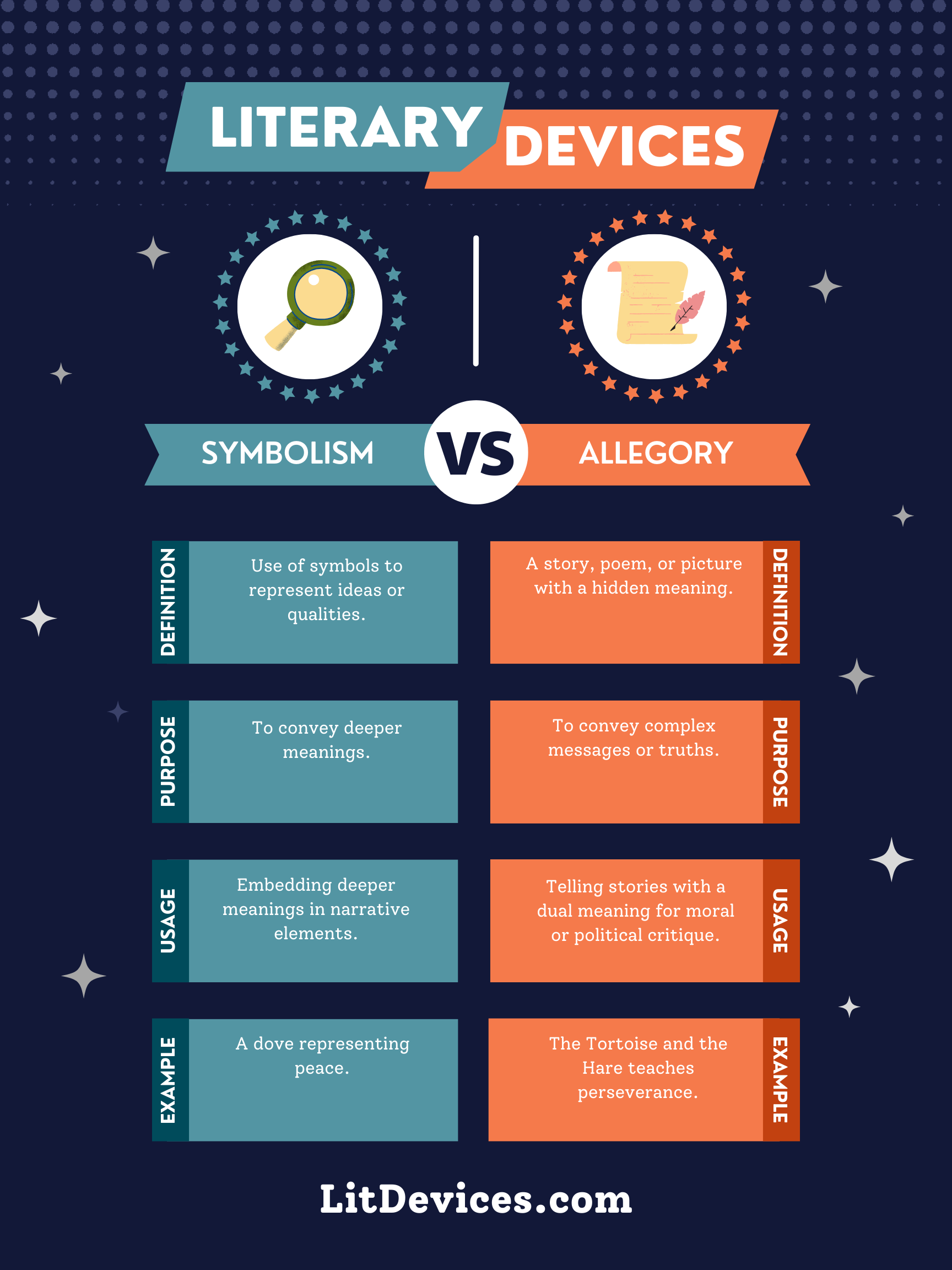Symbolism uses symbols to signify ideas and qualities; Allegory is a complete narrative that involves symbols representing deeper meanings.
Symbolism
Symbolism is the use of symbols—objects, figures, colors, or actions—to represent abstract concepts or ideas. It allows writers to convey complex messages and themes through the use of symbolic images or elements.
🌸 Example: In “The Great Gatsby” by F. Scott Fitzgerald, the green light at the end of Daisy’s dock symbolizes Gatsby’s hopes and dreams for the future, particularly his desire for Daisy.
Allegory
Allegory is a narrative technique in which characters, events, and details within a story operate on a secondary level of significance, often conveying moral, philosophical, or political meanings. Allegories are more structured and deliberate in their use of symbols to tell a parallel story.
🏰 Example: “Animal Farm” by George Orwell is an allegory for the Russian Revolution and the subsequent establishment of the Soviet Union, with farm animals representing different classes of society and historical figures.
Summary
| Literary Device | Definition | Purpose | Usage | Relevant Examples |
|---|---|---|---|---|
| Symbolism | The use of symbols to represent ideas or qualities beyond their literal sense. | To convey complex ideas and themes indirectly through imagery. | Found in all forms of literature, from poetry to prose, enriching the text with deeper meaning. | The green light in “The Great Gatsby.” |
| Allegory | A narrative that uses symbolic figures and actions to convey hidden meanings, often moral or political. | To present a story with a dual meaning, encouraging deeper reflection on the represented issues. | Used in novels, fables, and parables to critique social, moral, or political situations. | “Animal Farm” by George Orwell. |
Writing Tips
When incorporating symbolism or allegory into your writing:
- For Symbolism: Start by identifying the key themes or ideas you want to explore in your writing. Choose symbols that naturally align with these themes, ensuring they can be interpreted in multiple ways to add depth to your narrative.
- For Allegory: Plan your story’s secondary meaning from the outset. Each character, event, and setting should correspond to a specific idea or concept. Clarity is crucial in allegory to ensure the parallel meaning is accessible to the reader.
🖋 Example for Symbolism: To symbolize the theme of innocence lost in a coming-of-age story, you might use a broken childhood toy as a recurring image throughout the narrative.
🖋 Example for Allegory: In a dystopian novel that critiques contemporary political climates, construct a society with rules and characters that directly parallel real-world issues, such as censorship or inequality.
FAQs
Can a work of literature be both symbolic and allegorical?
Yes, many literary works contain elements of both symbolism and allegory, using symbols to convey deeper meanings while also presenting a narrative that serves as an allegory for a broader concept or issue.
How do I distinguish between symbolism and allegory?
Symbolism often operates on a smaller scale, using specific images or objects to suggest ideas indirectly. Allegory is more comprehensive, with the entire narrative serving as a metaphor for a larger message or critique.
Is allegory always obvious to the reader?
Not necessarily. While some allegories are clearly intended and easily interpreted, others may require deeper analysis to understand the parallel meanings or critiques being conveyed.
Exercise
Decide if the following descriptions are more indicative of symbolism or allegory:
- A story where spring flowers blooming represent the renewal of hope for the characters.
- A novel set in a futuristic society where different districts represent various forms of government control and resistance.
- A poem where darkness signifies the unknown fears of the human mind.
- A fantasy tale where the journey through a dense forest symbolizes the protagonist’s struggle with inner demons.
Answers:
- Symbolism
- Allegory
- Symbolism
- Symbolism
Interesting Literary Device Comparisons
- Metaphor vs. Allegory: While both use one thing to represent another, metaphors are concise comparisons that convey meaning in a direct, often single sentence or phrase. In contrast, allegory extends across an entire narrative, using characters and events to symbolize a larger message.
- Irony vs. Sarcasm: Irony involves stating something in a way that implies the opposite, often subtly and without explicit critique. Sarcasm, a form of verbal irony, is more direct and often used to mock or scorn.
- Simile vs. Symbolism: Similes make direct comparisons using “like” or “as” to illustrate similarities between different things. Symbolism uses an object or action to represent something more than its literal meaning, conveying complex ideas and themes indirectly.

